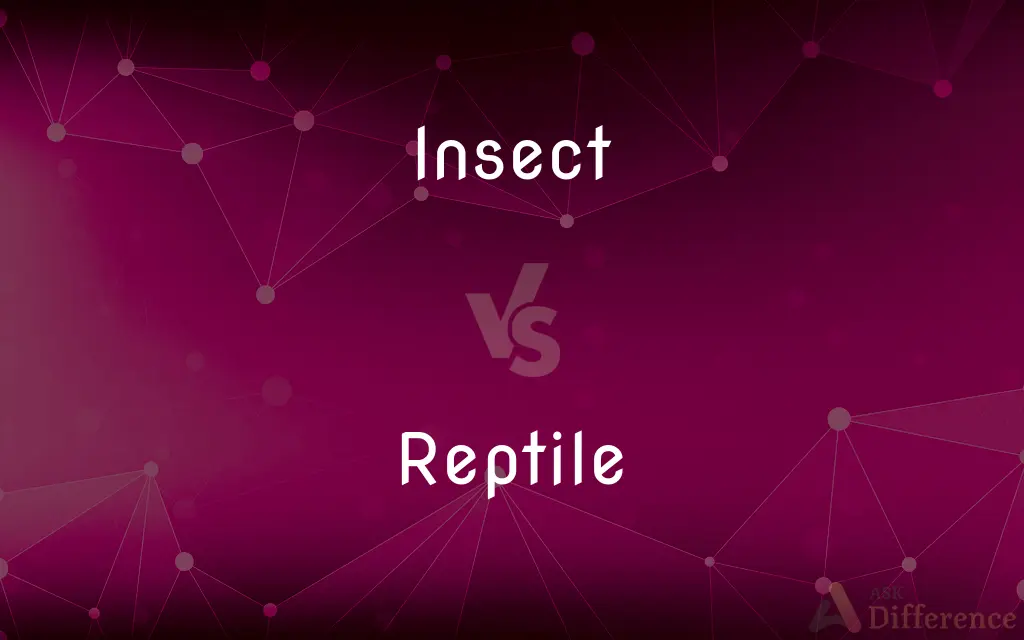Insect vs. Reptile — What's the Difference?
By Fiza Rafique & Maham Liaqat — Updated on March 13, 2024
Insects are small, six-legged arthropods with exoskeletons, while reptiles are cold-blooded vertebrates with scales or scutes.

Difference Between Insect and Reptile
Table of Contents
ADVERTISEMENT
Key Differences
Insects, belonging to the class Insecta, are characterized by their three-part body structure (head, thorax, abdomen), compound eyes, and one pair of antennae. They typically have six legs and most have wings at some stage of their development. In contrast, reptiles, which fall under the class Reptilia, include snakes, lizards, turtles, crocodiles, and alligators, featuring a physiology, scales or scutes covering their bodies, and they lay eggs with leathery shells or give birth to live young.
Insects play crucial roles in ecosystems, such as pollination, decomposing organic material, and serving as a food source for various animals. Reptiles also contribute significantly, often as predators that help control insect populations and as prey for larger predators, maintaining ecological balance. While insects are capable of flying or jumping, facilitating their role in pollination and spreading seeds, reptiles are primarily ground-dwellers or swimmers, with some capable of gliding.
The reproductive strategies of insects can vary widely, including laying eggs, live birth in some species, and complex life cycles with metamorphosis stages (e.g., caterpillar to butterfly). Reptiles, however, mainly reproduce by laying eggs, though some species exhibit ovoviviparity, where eggs hatch inside the mother's body, resulting in live birth.
Insects have been on Earth for approximately 400 million years, showcasing incredible diversity with over a million documented species, making them the largest group of animals on the planet. Reptiles have existed for about 310-320 million years, with less diversity but notable for their adaptation to various environments, from deserts to oceans.
Comparison Chart
Body structure
3-part body, 6 legs, often wings
Scales/scutes
ADVERTISEMENT
Reproduction
Varied, including egg-laying and live birth
Mainly egg-laying, some live birth
Role in ecosystems
Pollinators, decomposers, food source
Predators, ecological balance
Mobility
Flying, jumping
Ground-dwelling, swimming, some gliding
Diversity
Over 1 million species
Less diverse, adapted to various environments
Compare with Definitions
Insect
Three-Part Body.
Ants have a distinct separation between their head, thorax, and abdomen.
Reptile
Egg-Laying.
Many turtles lay eggs on land, even if they spend most of their life in water.
Insect
Ecosystem Role.
Flies decompose organic material, recycling nutrients back into the ecosystem.
Reptile
Predation.
Crocodiles are apex predators in their aquatic ecosystems.
Insect
Pollination.
Bees play a crucial role in the pollination of many flowering plants.
Reptile
Scales.
Snakes are covered in scales, aiding in movement and water retention.
Insect
Wings.
Butterflies are known for their colorful wings and migratory patterns.
Reptile
Adaptation.
Sea turtles have adapted to life in the ocean, though they return to land to lay eggs.
Insect
Diversity.
There are more species of beetles than any other type of insect.
Reptile
Reptiles, as most commonly defined, are the animals in the class Reptilia , a paraphyletic grouping comprising all amniotes except synapsids (mammals and their extinct relatives) and Aves (birds). The class comprises turtles, crocodilians, snakes, amphisbaenians, lizards, tuatara, and their extinct relatives.
Insect
Insects or Insecta (from Latin insectum) are pancrustacean hexapod invertebrates and the largest group within the arthropod phylum. Insects have a chitinous exoskeleton, a three-part body (head, thorax and abdomen), three pairs of jointed legs, compound eyes and one pair of antennae.
Reptile
A person regarded as contemptible or obsequious.
Insect
A small arthropod animal that has six legs and generally one or two pairs of wings
Insect pests
Reptile
A reptile or amphibian.
Insect
Any of various other small, chiefly arthropod animals, such as spiders, centipedes, or ticks, usually having many legs. Not in scientific use.
Reptile
(figuratively) A mean or grovelling person.
Insect
An insignificant or contemptible person.
Reptile
Creeping; moving on the belly, or by means of small and short legs.
Insect
An arthropod (in the Insecta class) characterized by six legs, up to four wings, and a chitinous exoskeleton.
Our shed has several insect infestions, including ants, yellowjackets, and wasps.
Reptile
Grovelling; low; vulgar.
A reptile race or crew
Reptile vices
Insect
(colloquial) Any small arthropod similar to an insect, including spiders, centipedes, millipedes, etc.
The swamp is swarming with every sort of insect.
Reptile
Creeping; moving on the belly, or by means of small and short legs.
Insect
(derogatory) A contemptible or powerless person.
The manager’s assistant was the worst sort of insect.
Reptile
Hence: Groveling; low; vulgar; as, a reptile race or crew; reptile vices.
There is also a false, reptile prudence, the result not of caution, but of fear.
And dislodge their reptile soulsFrom the bodies and forms of men.
Insect
One of the Insecta; esp., one of the Hexapoda. See Insecta.
Reptile
An animal that crawls, or moves on its belly, as snakes,, or by means of small, short legs, as lizards, and the like.
An inadvertent step may crush the snailThat crawls at evening in the public path;But he that has humanity, forewarned,Will tread aside, and let the reptile live.
Insect
Any air-breathing arthropod, as a spider or scorpion.
Reptile
One of the Reptilia, or one of the Amphibia.
Insect
Any small crustacean. In a wider sense, the word is often loosely applied to various small invertebrates.
Reptile
A groveling or very mean person.
Insect
Fig.: Any small, trivial, or contemptible person or thing.
Insect
Of or pertaining to an insect or insects.
Insect
Like an insect; small; mean; ephemeral.
Insect
Small air-breathing arthropod
Insect
A person who has a nasty or unethical character undeserving of respect
Common Curiosities
Can reptiles fly?
Most reptiles cannot fly; however, some species, like the Draco lizard, can glide.
What is the significance of an insect's three-part body?
The three-part body structure allows for specialized functions, like sensory input (head), movement (thorax), and digestion (abdomen).
How do reptiles contribute to the control of insect populations?
Many reptiles, such as certain lizard species, feed on insects, helping to control insect populations and prevent outbreaks.
Do all insects have wings?
Not all insects have wings, but many do at some point during their life cycle.
How do insects reproduce?
Insects reproduce in various ways, including laying eggs, live birth, and complex life cycles involving metamorphosis.
How do insects and reptiles help ecosystems?
Insects act as pollinators, decomposers, and a food source, while reptiles maintain ecological balance as predators and prey.
Are all insects beneficial to the environment?
While many insects are beneficial, some can be pests, causing harm to crops, buildings, and sometimes spreading diseases.
What is the oldest known insect?
The oldest known insects date back to around 400 million years ago, during the Devonian period.
Can reptiles live in water?
Some reptiles, like sea turtles and certain snakes, are adapted to live in aquatic environments.
What challenges do insects face?
Insects face challenges such as habitat loss, climate change, and pesticide use, which can threaten their populations.
What role do insects and reptiles play in food webs?
Both insects and reptiles are integral to food webs, serving as both predators and prey, contributing to the flow of energy through ecosystems.
Share Your Discovery

Previous Comparison
Lysine vs. Arginine
Next Comparison
Pedagogy vs. DidacticAuthor Spotlight
Written by
Fiza RafiqueFiza Rafique is a skilled content writer at AskDifference.com, where she meticulously refines and enhances written pieces. Drawing from her vast editorial expertise, Fiza ensures clarity, accuracy, and precision in every article. Passionate about language, she continually seeks to elevate the quality of content for readers worldwide.
Co-written by
Maham Liaqat















































